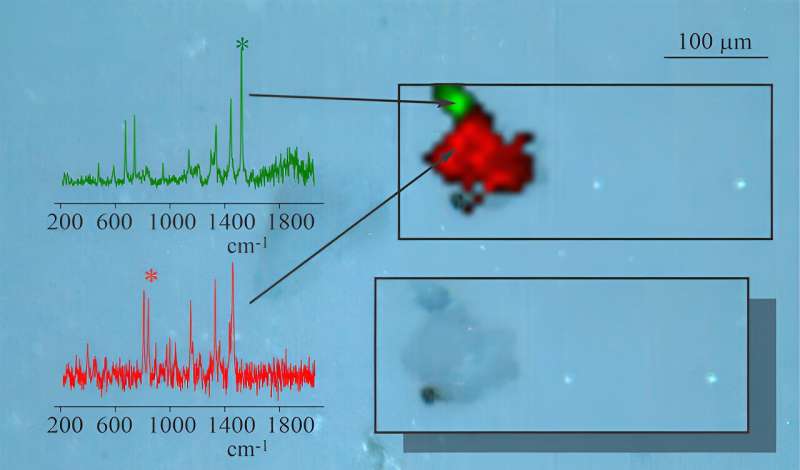This article has been reviewed according to Science X's editorial process and policies. Editors have highlighted the following attributes while ensuring the content's credibility:
fact-checked
peer-reviewed publication
trusted source
proofread
Many microplastics in the world's oceans have likely escaped detection, researchers say

Chemicals within microplastics that are found in our world's oceans and waterways, and in drinking water sources, remain of concern to scientists and public health officials. A new study that investigated the presence of the smallest particles of microplastics (MPs) in ocean waters from the Caribbean to the Arctic found that the most abundant (and tiny) MPs in the ocean are not being detected by net tow surveys.
The research was conducted by scientists in the School of Marine and Atmospheric Sciences (SoMAS) at Stony Brook University, and led by Luis Medina Faull, Ph.D. Their findings are described in a paper published in the May edition of the Marine Pollution Bulletin.
The proliferation of MPs in aquatic systems is dangerous as they can have negative biological effects on living creatures in the sea and on land. Additionally, MPs can enter the larger food web and make their way up to humans through seafood consumption.
The use of Raman microspectroscopy to investigate many samples of sea surface water led to the findings. The laboratory technique is vibrational spectroscopy that combines with a microscope to detect and chemically identify minute particles in environmental samples. The samples were taken from three distinct global ocean regions: The Northeastern Coast of Venezuela; the Gulf Stream Current, encompassing Caribbean waters and throughout the Atlantic Ocean; and the Pacific Arctic Ocean.
Standard net tow surveys in oceans detect MPs as tightly meshed "plankton nets" sieve out MP particles during the tow. However, viewing ocean water samples under Raman microspectroscopy opens up a new world in defining the smallest of particles. The researchers measured MP detection in micrometers. One micrometer is one-millionth of a meter, about the size of a common bacterium like E. coli. Plankton nets detect particles mostly from 300 to 500 micrometers and seldom smaller. Medina Faull and colleagues commonly detect MPs at sizes well under 15 micrometers.
"Our results highlight the numerical primacy of small MP particles in seawater, and we found that the most abundant MPs were between 1 and 14 micrometers, 60 percent were under 5 micrometers, and none were larger than 53 micrometers," says Medina Faull, Lecturer and IDEA Fellow, Sustainable Climate Justice and Solutions, in SoMAS. "This size fraction has been totally overlooked in almost all marine MP surveys."
In addition, the MP detection method also enabled the researchers to determine MP particle identities and sizes from which masses were calculated. He explained that this is a critical component of the work because mass-based inventories lead to more accurate and meaningful estimations of global oceanic plastic inventories, thereby providing vital information for mass flux calculations of MPs through aquatic ecosystems.
The research team reported that based on published MPs surveys in oceans around the globe, their work detected MPs less than 53 micrometers at a rate of six orders of magnitude higher than all of the combined reports. That translates to hundreds of thousands more MPs.
Potential impact on human health and wider research
These smallest of MPs detected in this study also contained chemicals potentially dangerous not only to marine life but to human health if consumed significantly though the food web. The most abundant polymers detected were polypropylene, polystyrene, and polyethylene, which is consistent with the composition of plastic waste generated globally in oceans.
"Understanding health risks from exposure to microplastics is a vastly understudied area, and investigations are needed to understand the health impacts from microplastics of different shapes, sizes, and compositions," says Jaymie Meliker, Ph.D., Professor in the Program of Public Heath, and in the Department of Family, Population and Preventive Medicine in the Renaissance School of Medicine at Stony Brook University, who was not involved in the study.
Meliker's call for more public health research on exposure to microplastics includes investigation on MPs that may enter human consumption through the seafood web, other dietary sources, or via drinking liquids in plastic bottles.
Medina Faull suggests wider research on addressing and capturing the proliferation of MPs in the world's oceans remains challenging.
"Firstly, most of the ocean is grossly under-sampled, and the majority of existing data is based on towed net studies. And smaller, less buoyant MP particles residing below the ocean's upper few meters are almost never sampled. Secondly, understanding sources of MPs transport and final landing locations such as ocean floors is crucial to explain the distribution patterns of MPs throughout the ocean," he explains.
More information: Luis E. Medina Faull et al, From the Caribbean to the Arctic, the most abundant microplastic particles in the ocean have escaped detection, Marine Pollution Bulletin (2024). DOI: 10.1016/j.marpolbul.2024.116338
Journal information: Marine Pollution Bulletin
Provided by Stony Brook University




















